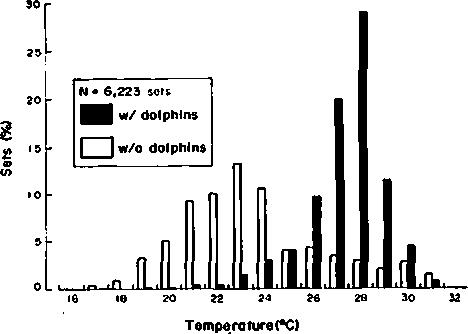Fishbyte Section
From the Editor
This is the Hrst issue of Naga with a Fishbyte section - we are still
in touch!
The papers presented here are in part Fishbyte backlog papers -
some selected to match the "tuna" theme of this issue of Naga - in
part papers written to inaugurate this section. This applies especially
tothatof LM. Vakilywhichdocuments aprojectwhich we hope will
Serveasamodeltoother Countriesin West AHicaandelsewherein
the developing world. Feedback on this and on the Otherpapers are
welcome. D. Paufy

Relationship Between Sea Surface Temperatures and
Dolphin-Associated Fishing Activities by the
Mexican Tuna Fleet
VICTOR M. GOMEZ-MUNOZ
Abstract
Data from the Mexican purse seiner fleet operating in the eastern
tropical Pacific, for the year 1985-1990, are used to show that the fraction
of surface schools of yellowfin tuna TTiunnus albacores associated with
dolphins (Stenella attenuate and others) increases with sea surface
temperature (P<0.01). Possible reasons for this correlation are briefly
discussed.
Introduction
The Mexican purse-seine fishers in the eastern tropical
Pacificdetectschoolsofyellowfin tuna ( Thunnus albacares)
in several ways: floatingobjects (commonly called "logs"),
surface disturbances ("brisa") caused by tuna and their
prey and the presence of birds or marine mammals. In
1985-90, more than half the sets were associated with
dolphins, which suggests that tuna schools are best
detected through dolphin sightings. However, nocorrelation
has been found between tuna catch and the nurhber of
dolphins sighted, nor between the catch and the number
of dolphins confined in the net. Hence the success of
fishing does not seem to depend on density of dolphin
schools.
Surface schooling of tuna with dolphins occurs when
a shallow thermocline limits the vertical distribution of
the two species to the surface layer (Au and Perryman
1985). In 1981, staff of the Inter-American Tropical Tuna
Commission performed a discriminant function analysis
of several physical factors to determine which were
related to high and low catches of yellowfin tuna. In the
551 Casesexamined Whereyellowfin tuna Wereassociated
with dolphins, the gradient of thermocline was the only
statistically significant discriminator (Anon. 1983). In
fact a shallow thermocline probably acts as a vertical
aggregating mechanism for the squids and fishes on
which dolphins prey, along with tuna (Reilly 1990).
Association between Tunas and Dolphins
The spotted dolphin Stenella attenuata is the species
most often associated with Mexican tuna fishing, being
represented in almost 90% all purse-seine sets. The historical
range of this species in the eastern tropical Pacific, as
reported by Perrin et al. (1983), is similar to the operating
range of the tuna fleet, as can be seen, e.g., in the maps of
Ortega-Garcia (1989).
Blackburn (1965) and Nakamura (1969) have shown
that the overall limits Ofdistribution of most tuna species
can be clearly defined by sea surface temperature (SST).
Variations in dolphin sets showed maxima in zones of
higher SST. Also, significant differences in SST and
success of fishing found between the dolphin and the
nondolphin associated sets: dolphin-associated Setsoccurred
more frequently ata mean of 28 *C, with an average of 13
t per set; while most nondolphin sets occurred at a mean
of 23 *C, with not quite 91 per set (Fig. 1). Au et al. (1979)

Fig. 1 • Percentage, In the Mexican (eaatom Pacific) tuna fleet,
of dolphin and nondolphin seta as a function of SST 1985∙90.
24
NAGA1 THE ICLARM QUARTERLY
More intriguing information
1. The name is absent2. A Consistent Nonparametric Test for Causality in Quantile
3. The name is absent
4. The Macroeconomic Determinants of Volatility in Precious Metals Markets
5. Party Groups and Policy Positions in the European Parliament
6. Word searches: on the use of verbal and non-verbal resources during classroom talk
7. Wirtschaftslage und Reformprozesse in Estland, Lettland, und Litauen: Bericht 2001
8. The name is absent
9. Partner Selection Criteria in Strategic Alliances When to Ally with Weak Partners
10. The purpose of this paper is to report on the 2008 inaugural Equal Opportunities Conference held at the University of East Anglia, Norwich